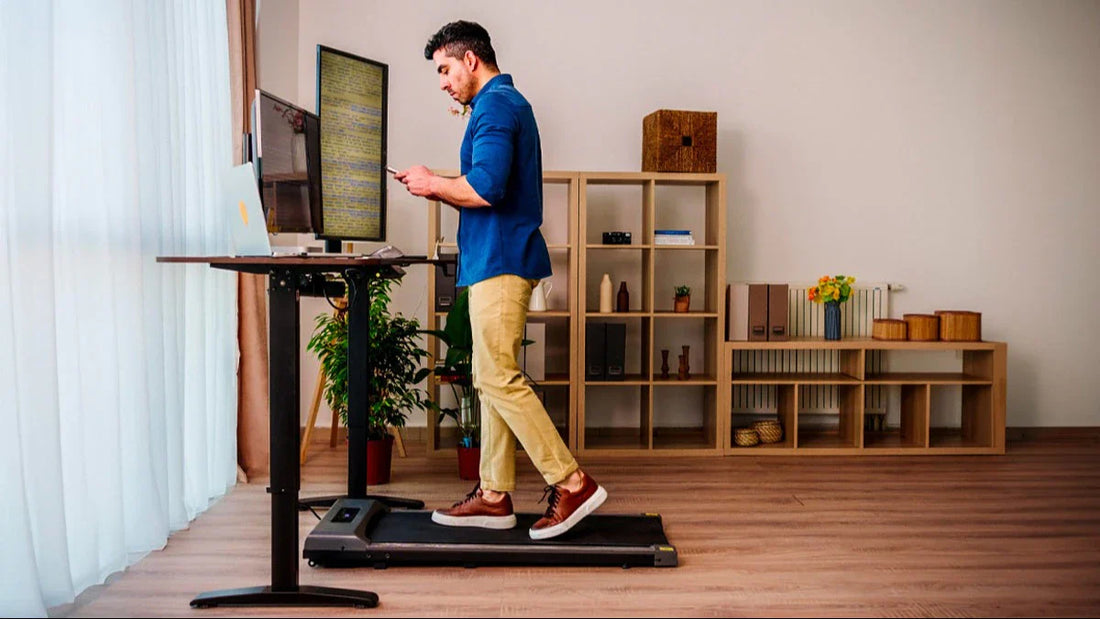5 Benefits of Using a Walking Pad at Home
Remote work has increased the amount of time we spend sitting. While convenient, long periods of sitting contribute to stiffness, fatigue, and health risks. A walking pad offers a simple solution.
A walking pad is a slim, foldable treadmill designed for everyday use. Unlike traditional treadmills, it’s compact, quiet, and easy to fit into a home office. Adding one to your workspace allows you to move more during the day without interrupting your routine.

Here are the key benefits of using a walking pad:
1. Low-Impact Movement That’s Sustainable
Walking pads provide gentle, low-impact exercise that reduces strain on joints. This makes them accessible to people of all fitness levels. Even short sessions throughout the day improve circulation, reduce stiffness, and support long-term joint health.
2. Natural Support for Weight Management
Walking on a walking pad burns calories steadily without feeling like structured exercise. Integrated into work tasks—emails, calls, or research—it adds meaningful activity to your day. Over time, these small increments of movement contribute to better weight management and energy balance.
3. Improved Balance and Mobility
Consistent walking develops coordination and core stability. Unlike prolonged sitting, which weakens postural muscles, walking pads keep the body engaged. This supports mobility, balance, and overall functional health—important for maintaining long-term movement confidence.
4. Combine Movement With Work
Walking pads are designed to fit seamlessly into daily life. They’re quiet, quick to set up, and allow for multitasking. Many users find walking enhances concentration, making it easier to sustain focus during repetitive or administrative tasks.
5. Boost in Mood and Cognitive Performance
Movement is linked with the release of endorphins, improved circulation, and sharper mental clarity. Short walking sessions help reduce fatigue, refresh focus, and lift mood. For home workers, this can mean fewer afternoon slumps and more consistent productivity.
Evidence Behind Walking Pads
Research consistently shows that prolonged sitting is linked with higher risks of cardiovascular disease, diabetes, and reduced life expectancy. Regular light-intensity walking helps counteract these effects.
Walking pads make this possible without requiring extra time in the day. Even at slow speeds, they increase daily step counts, calorie expenditure, and energy levels. Importantly, they do so in a way that is sustainable because the activity is built into work, not separated from it.
Why We Recommend Walking Pads
Our philosophy is simple: a workspace should support both your body and your mind. A walking pad does exactly that. It brings movement into environments that are often dominated by stillness, without demanding extra time, effort, or space.
What makes walking pads stand out is how well they fit modern work and living habits:
-
Compact and Space-Smart – Unlike bulky treadmills, walking pads fold away neatly under a desk, bed, or sofa. They’re designed for real homes and real workspaces, not just gyms.
-
Quiet and Considerate – With smooth, brushless motors, walking pads let you walk, think, and work without distraction—or disturbing those around you.
-
Minimalist Aesthetic – Clean lines and neutral finishes blend naturally into home offices, keeping your space calm and uncluttered.
-
Effortless to Use – Whether through remote, app, or simple foot control, the setup is intuitive and quick. No steep learning curve, just plug in and start moving.
In our view, this balance of ergonomic function, space efficiency, and ease of use makes walking pads one of the most effective tools for creating a workspace that nurtures both productivity and wellbeing.
How to Get Started With a Walking Pad
-
Start Slow – Begin with short sessions at 1–2 km/h and increase gradually.
-
Alternate Postures – Mix walking with sitting and standing for comfort.
-
Check Ergonomics – Desk height and screen position should support upright posture while walking.
-
Use Supportive Footwear – Comfortable shoes reduce strain during longer sessions.
-
Choose Suitable Tasks – Light work such as emails, calls, or reading pairs best with walking.

Conclusion
A walking pad is a practical way to add daily movement without sacrificing productivity. It reduces sedentary time, supports weight management, improves focus, and enhances overall wellbeing.
For anyone building a healthier home office, a walking pad offers a simple, effective upgrade. We recommend them as part of a workspace designed to improve both comfort and long-term health.

